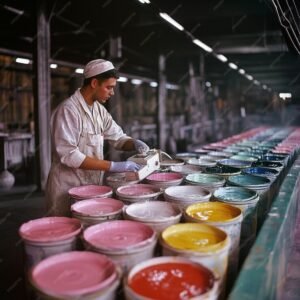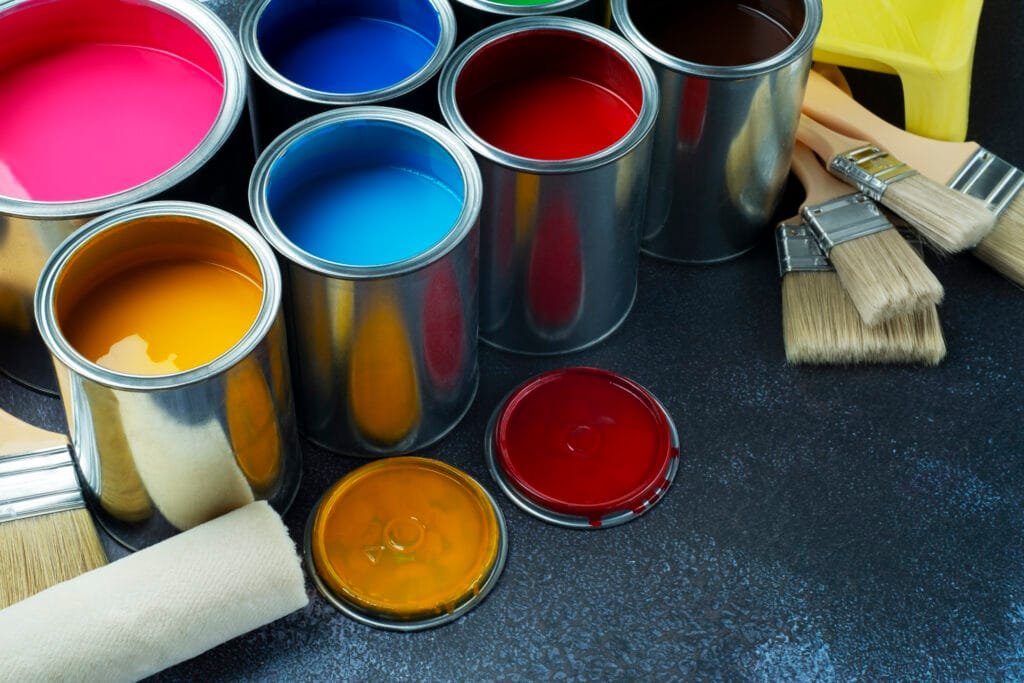Introduction to Manufacturing Process
Mithila Paints has emerged as a hallmark of excellence within the paint manufacturing industry, reflecting a commitment to quality that resonates throughout its operations. Established with the intent to blend traditional craftsmanship with modern technology, Mithila Paints draws its inspiration from the rich cultural heritage of the Mithila region, renowned for its distinctive art forms. Since its inception, the company has been dedicated to promoting not just aesthetically pleasing products, but also environmentally sustainable practices.
The mission of Mithila Paints is anchored in its desire to provide superior quality paints that cater to the diverse needs of its customers while simultaneously upholding ecological responsibility. The company prioritizes the use of non-toxic, eco-friendly materials in its formulations, ensuring minimal environmental impact. By doing so, Mithila Paints not only enhances the aesthetic appeal of spaces but also promotes healthier living environments.
Mithila Paints envisions a future where art and sustainability coexist harmoniously. By integrating contemporary manufacturing techniques with traditional artistry, the company aims to create products that are not only visually stunning but also support communities involved in the crafting process. This dual focus enhances the socio-economic fabric of the Mithila area, fostering local artisanship while introducing products that stand the test of time in quality and design.
The company’s dedication to innovation and sustainability has positioned it as a reputable player in the paint manufacturing sector. With an unwavering commitment to excellence, Mithila Paints continues to champion the practice of creating not just paint, but enduring legacies of art and ecological awareness. It is within this framework that Mithila Paints seeks to redefine the landscape of the paint industry, setting new standards for quality and environmental consciousness.
Understanding the Basics: Types of Paints Manufactured
Mithila Paints is renowned for its diverse range of paint products, each specifically crafted to meet various needs and applications. The primary types of paints manufactured include emulsion paints, enamels, and primers, each possessing unique properties that cater to different requirements in the painting process.
Emulsion paints are water-based and are known for their ease of application, quick drying times, and minimal odor. This type of paint is ideal for interior walls as it offers excellent coverage and can be easily cleaned with water. The formulation also allows for a breathable finish, which helps prevent peeling and blistering. Emulsion paints are available in various finishes, such as matte, eggshell, and satin, providing options that can enhance the aesthetic appeal of any space.
Enamel paints, on the other hand, are oil-based and are characterized by their durability and glossiness. These paints are typically used for surfaces that require a tough finish, such as wood, metal, and high-traffic areas. Enamel paints excel in providing a hard, protective coating that can withstand the test of time, making them suitable for both indoor and outdoor applications. Moreover, they are resistant to stains and wear, which is why they are often employed in commercial settings where durability is paramount.
Primers play a critical role in the painting process, serving as a preparatory coat that enhances adhesion and durability. They are specifically designed to bind well with the surface, ensuring that subsequent layers of paint adhere effectively. Primers can also help conceal imperfections and improve the overall finish of the paint applied over them. Using the appropriate primer can significantly impact the longevity and appearance of the final coat, making it an essential component in the paint manufacturing process at Mithila Paints.
Raw Materials: The Building Blocks of Paint
The quality and performance of paints are significantly influenced by the selection and use of raw materials. At Mithila Paints, a careful consideration of these components ensures that the final products not only meet the desired aesthetic standards but also adhere to industry performance benchmarks. The primary categories of raw materials include pigments, binders, solvents, and additives, each playing a crucial role in the manufacturing process.
Pigments are integral to paint, providing color and opacity. They can be categorized into organic and inorganic types, with organic pigments offering vivid colors, while inorganic pigments are known for their durability and lightfastness. Selecting the appropriate pigment is vital as it affects the hue, stability, and overall appearance of the paint. At Mithila Paints, a diverse palette of pigments is sourced to ensure a wide range of colors that meet the specific requirements of our clients.
Binders act as the adhesive component in paint, ensuring that pigments are securely held together and can adhere to surfaces. They contribute to paint’s durability, glossy finish, and resistance to environmental factors. Common types of binders include acrylics, vinyls, and alkyds, each chosen according to the application needs. The formulation of binders used at Mithila Paints is aimed at striking a balance between flexibility and hardness, thereby ensuring long-lasting performance.
Solvents, another essential component, determine the viscosity and application properties of paint. They serve as carriers for other ingredients and facilitate ease of application. At Mithila Paints, the selection of solvents is done with an eye towards environmental impact, favoring those that are less volatile and more eco-friendly, aligning with our commitment to sustainable practices.
Lastly, additives enhance various characteristics of paint, such as drying time, mildew resistance, and stability, allowing for a more refined and applicable paint product. The careful selection and combination of these raw materials at Mithila Paints are pivotal, ultimately influencing the functionality and efficacy of the paint, thereby underscoring the art of paint manufacturing.
The Manufacturing Process: Step by Step
The manufacturing process at Mithila Paints is a carefully orchestrated series of steps designed to ensure that each product meets stringent quality standards while maintaining consistency throughout production. The initial phase begins with the formulation of paint recipes, which involves selecting raw materials such as pigments, solvents, resins, and additives. Each of these components is meticulously chosen based on their properties and how they contribute to the final product’s performance.
Once the formulations are established, the next stage is mixing. This step involves combining the selected raw materials in precise ratios using industrial mixers. The mixing process is crucial, as it ensures that the pigments are evenly dispersed throughout the mixture, leading to a uniform appearance and consistent quality in the paint. Attention to detail during this phase is essential, as inaccuracies can affect the final color and texture.
After mixing, the paint undergoes milling, where it is processed through high-energy machines. The purpose of milling is to further break down pigment particles and achieve a smooth consistency. This part of the process also helps improve the paint’s performance characteristics, such as its flow and leveling attributes. Quality control checks are performed at this stage to ensure that the paint meets the desired specifications before moving on to packaging.
The final step in the manufacturing process is packaging. This involves filling containers of various sizes, labeling them accurately, and preparing them for shipment. The packaging process is optimized not only for efficiency but also to maintain the integrity of the paint. Throughout each step, Mithila Paints employs rigorous quality assurance measures, underscoring its commitment to delivering top-notch products to consumers.
Quality Control: Ensuring Excellence
Quality control is a crucial aspect of the manufacturing process at Mithila Paints, as it guarantees that every product released to the market meets stringent performance and safety standards. The approach to quality assurance begins right from the selection of raw materials, where only high-grade components are procured from trusted suppliers. This foundational step is paramount, as the quality of the materials directly affects the final product’s characteristics and durability.
Once the raw materials arrive at the facility, they undergo a rigorous inspection. Each batch is tested for its physical, chemical, and performance properties to ensure that they align with Mithila Paints’ specifications. This initial assessment prevents subpar materials from progressing through the manufacturing stages, thereby averting potential issues later in the process. The quality control team meticulously monitors these materials, which sets the stage for the formulation of paints that are not only vibrant and appealing but also compliant with regulatory standards.
As the manufacturing process unfolds, multiple testing phases are integrated. During the mixing and blending stages, samples are regularly taken and analyzed for consistency in color, viscosity, and texture. This enables the company to identify any deviations from the desired formula early on, allowing for immediate corrections. Furthermore, before the final product is packaged, it undergoes a comprehensive inspection that includes tests for adhesion, gloss levels, and drying times. Only those batches that meet the established criteria proceed to the packaging phase.
Continuous improvement is embedded in the quality control culture at Mithila Paints. Feedback from customers is actively sought and analyzed, which informs adjustments in both manufacturing processes and quality assurance protocols. This commitment to excellence ensures that each can of paint not only meets but exceeds consumer expectations, fortifying Mithila Paints’ reputation as a leader in the industry.
Sustainability Practices at Mithila Paints
Mithila Paints is firmly committed to sustainability, incorporating eco-friendly practices into every stage of its manufacturing process. By prioritizing environmental responsibilities, the company aims to minimize its ecological footprint while producing high-quality products. One of the core tenets of sustainability at Mithila Paints is waste reduction. The organization has implemented strict waste management protocols to ensure that waste is minimized during production. This involves optimizing material usage and recycling scrap materials whenever possible, which not only conserves resources but also supports the circular economy.
Furthermore, Mithila Paints sources eco-friendly raw materials for its paints. The company recognizes the importance of using non-toxic, sustainable ingredients that do not harm the environment or the health of consumers. By carefully selecting suppliers who share a commitment to sustainable practices, Mithila Paints ensures that its products are not only vibrant but also safe and environmentally benign. This dedication to sourcing responsibly contributes to the overall sustainability of the manufacturing process.
Energy efficiency is another significant focus at Mithila Paints. The company continually seeks to reduce its energy consumption through various initiatives, such as utilizing energy-efficient machinery and optimizing production schedules to align with off-peak energy hours. By reducing energy usage, Mithila Paints not only lowers its operational costs but also minimizes greenhouse gas emissions associated with its manufacturing activities. This approach not only highlights the company’s commitment to sustainability but also positions the brand as a leader in environmentally conscious practices within the industry.
Through these combined efforts—waste reduction, eco-friendly raw materials, and energy efficiency—Mithila Paints demonstrates a comprehensive approach to sustainability. This commitment is integral to the company’s operations and its goal to create a lasting positive impact on the environment, solidifying its role as a forward-thinking entity in the paint manufacturing sphere.

Innovation and Technology in Paint Manufacturing
The manufacturing process at Mithila Paints is characterized by a strong emphasis on innovation and technology, which plays a pivotal role in enhancing product quality and operational efficiency. At the heart of this approach lies the integration of advanced machinery that facilitates precision in the mixing and formulation of paints. Utilizing state-of-the-art equipment, Mithila Paints ensures that each batch meets the strictest standards, guaranteeing consistency in color and texture. This technological investment not only improves the quality of the paints but also streamlines production, reducing waste and improving sustainability.
Automation has further revolutionized the manufacturing process at Mithila Paints. By implementing automated systems, the company minimizes human error and accelerates workflows, allowing for higher output without compromising quality. These automated solutions range from computer-controlled mixing stations to robotic packing systems. Such innovations not only enhance efficiency but also enable the company to respond swiftly to market demands and customer needs, thus maintaining a competitive edge in the industry.
Research and development (R&D) stand as another cornerstone of innovation within Mithila Paints. The R&D team continuously explores new materials and eco-friendly formulas, aiming to produce paints that are not only aesthetically pleasing but also sustainable. Collaboration with academic institutions and industry experts fuels the creative process, pushing the boundaries of what is achievable in paint technology. This commitment to innovation ensures that Mithila Paints remains at the forefront of advancements, capable of introducing products that meet contemporary environmental standards while fulfilling the artistic needs of its customers.
In conclusion, the integration of innovation and technology in the manufacturing process at Mithila Paints is instrumental to its enduring success. Through advanced machinery, automation, and dedicated research and development, the company continually elevates product quality and operational efficiency.

Customer Engagement: Understanding Market Needs
At Mithila Paints, customer engagement serves as a cornerstone of product development and overall business strategy. The company recognizes that comprehending market needs is crucial to delivering high-quality products that resonate with consumers. By fostering an open line of communication with their client base, Mithila Paints can accurately identify preferences, trends, and the evolving demands of the marketplace.
One of the primary methods used to gather customer insights is through feedback mechanisms. Mithila Paints actively solicits opinions from its clients through surveys, social media interactions, and direct consultations. This feedback not only helps in refining existing paint formulations but also guides new product developments. By analyzing feedback data, the company can prioritize features that matter most to its customers, such as eco-friendliness, durability, and aesthetic appeal.
The importance of customer service in this engagement process cannot be overstated. Mithila Paints places significant emphasis on providing exceptional service to establish a strong rapport with its clientele. The customer service team is trained to address inquiries, resolve issues, and provide expert advice on product selection. By creating a responsive and knowledgeable support system, the company builds trust and loyalty among consumers, enhancing their overall experience.
Furthermore, Mithila Paints actively participates in community events and exhibitions to connect with potential customers. These engagements allow the company to showcase its products while collecting valuable information regarding public preferences and perceptions. Combining direct interaction with feedback data equips Mithila Paints with a comprehensive understanding of its customer base, ultimately driving innovation and satisfying market demands.

Conclusion: The Future of Paint Manufacturing at Mithila Paints
As we have explored throughout this blog post, Mithila Paints stands at the intersection of tradition and innovation in the world of paint manufacturing. Established with a vision for quality and sustainability, the company has seen a steady evolution in its processes, adapting to market needs while retaining its commitment to traditional artistry. With the growing consumer demand for eco-friendly products, Mithila Paints is poised to capitalize on this trend by integrating sustainable practices into its production lines.
Looking ahead, one of the key market trends is the shift toward environmentally responsible paint options. Consumers are increasingly informed about the impacts of their purchases, and this awareness is set to influence the manufacturing strategies of paint producers. Mithila Paints is already taking steps to enhance its products’ eco-friendliness, focusing on natural pigments and less harmful chemicals. These efforts not only align with consumer preferences but also reinforce the company’s commitment to sustainability.
Moreover, the integration of emerging technologies into the manufacturing process offers numerous opportunities for Mithila Paints. Automation and smart production systems are gradually being adopted, promising greater efficiency and consistency in product quality. The digitalization of supply chain management can lead to better inventory control and customer service, enhancing overall operational performance. The company’s journey toward implementing such technologies will be crucial in maintaining a competitive edge in the paint manufacturing landscape.
In conclusion, Mithila Paints is not only preserving the rich heritage of traditional painting techniques but is also looking toward a future where innovation and sustainability are pivotal. By embracing market trends and technological advancements, Mithila Paints aims to enrich its product offerings and build a stronger foothold in the dynamic paint industry.


